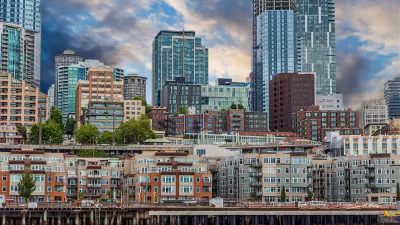Living arrangements designed to encourage social interaction and provide shared facilities can lower the cost of living and build more friendly, supportive neighborhoods.

In a piece for Strong Towns, Emma Avery describes the potential of ‘cohousing:’ housing arrangements with shared amenities that bring down housing costs for residents and create more opportunities for social interactions.
Residents of cohousing projects, Avery explains, “own their private units, but share extensive common spaces. They commit to regular community activities, like meals, and manage the building together.”
Avery highlights an example from Vancouver, where a group of residents joined with a local developer to build their dream communal community. “Over several years, Happy Cities worked with Our Urban Village (formerly called Tomo House) and the design team to help create a super social building — and then to measure whether residents really did feel more connected after moving into their new home.” Results from resident surveys showed a dramatic reduction in loneliness and isolation and an increase in social connections between neighbors.
Noting the barriers to building this type of housing model, Avery argues that cities should make it easier to develop cohousing. “This means offering public land for affordable, socially connected housing; legalizing more density citywide; providing incentives to encourage social design features and offset the costs; and more.” Bringing social connection back into housing developments and neighborhoods can create more sustainable development patterns, help address the housing crisis, and alleviate the growing ‘loneliness epidemic.’
FULL STORY: Can Cohousing Solve the Housing Crisis and Loneliness Epidemic?

Maui's Vacation Rental Debate Turns Ugly
Verbal attacks, misinformation campaigns and fistfights plague a high-stakes debate to convert thousands of vacation rentals into long-term housing.

Planetizen Federal Action Tracker
A weekly monitor of how Trump’s orders and actions are impacting planners and planning in America.

In Urban Planning, AI Prompting Could be the New Design Thinking
Creativity has long been key to great urban design. What if we see AI as our new creative partner?

King County Supportive Housing Program Offers Hope for Unhoused Residents
The county is taking a ‘Housing First’ approach that prioritizes getting people into housing, then offering wraparound supportive services.

Researchers Use AI to Get Clearer Picture of US Housing
Analysts are using artificial intelligence to supercharge their research by allowing them to comb through data faster. Though these AI tools can be error prone, they save time and housing researchers are optimistic about the future.

Making Shared Micromobility More Inclusive
Cities and shared mobility system operators can do more to include people with disabilities in planning and operations, per a new report.
Urban Design for Planners 1: Software Tools
This six-course series explores essential urban design concepts using open source software and equips planners with the tools they need to participate fully in the urban design process.
Planning for Universal Design
Learn the tools for implementing Universal Design in planning regulations.
planning NEXT
Appalachian Highlands Housing Partners
Mpact (founded as Rail~Volution)
City of Camden Redevelopment Agency
City of Astoria
City of Portland
City of Laramie





























